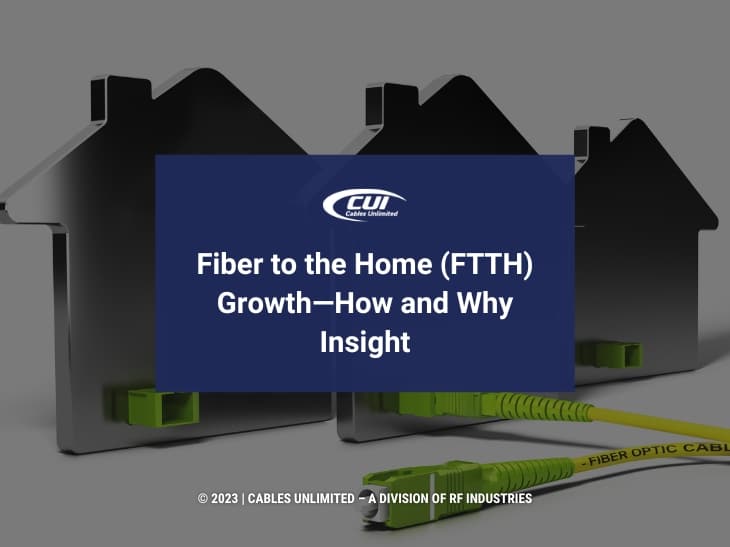The global Fiber to the Home (FTTH) market is currently forecast to end 2023 at $23.4 billion, increasing at a compound annual growth rate (CAGR) of 15.1%, reaching nearly $96 billion by 2033. The key drivers of this growth are increased broadband penetration, rising Internet television streaming services, and the overall growing telecommunication industry. All these factors are driving an ever-increasing use of fiber optic cables.
This article defines FTTH, highlights its benefits, digs deeper into the factors behind its growth, and covers how it works.
What Is Fiber to the Home (FTTH)?
Fiber to the Home (FTTH) is a broadband network architecture that employs optical fibers to carry high-speed internet and other communication services directly to homes. It is a significant improvement over traditional coaxial cable or twisted pair copper wiring.
FTTH is often called “all-fiber” because it replaces the traditional copper wiring with optical fibers. The fibers are connected to homes and businesses through a central office switch or head-end, which connects the optical fibers and the home.
This same approach is also used for fiber to the building (FTTB), curb (FTTC), desk (FTTD), and premises (FTTP). All these locations can take advantage of fiber optic cable’s faster speeds of up to 1 Gbps. This is compared to the coaxial cable or twisted pair speeds of up to only 100 Mbps.
Fiber to the Curb (FTTC): Insight Into Advantages and Applications
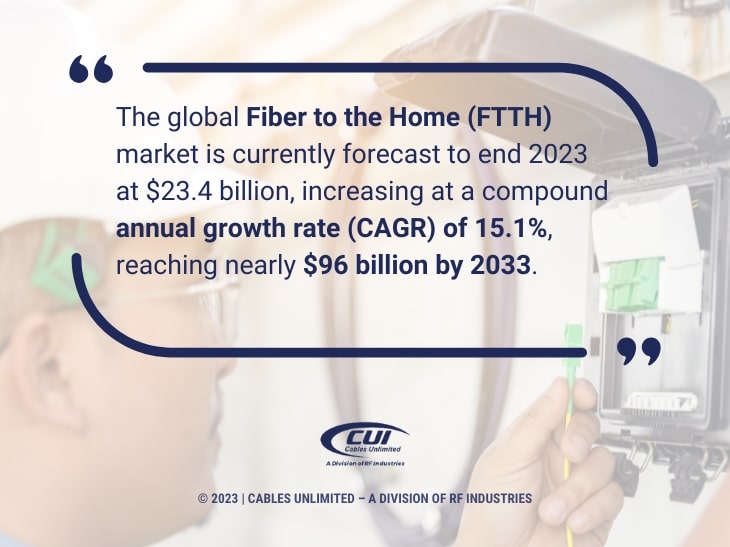
What are the Benefits of Fiber to the Home (FTTH)?
As noted above, the transmission speed and broader bandwidth are significant benefits of using fiber optic cable in almost every possible application. With fiber to the home, there are even more benefits.
- Enhanced Security. Fiber optic cables do not radiate signals, as does copper or coax. It’s also tough to tap into a fiber optic cable. Those characteristics greatly enhance security and avoid cybersecurity challenges.
- Reduced Interference. Those same fiber optic cable characteristics that enhance security also minimize interference from outside signals. That results in less signal degradation and disruptions from outside EMI and RFI than traditional copper-based networks.
- Improved Durability. Optical fiber cables are more durable than copper twisted pair and coaxial cable, requiring less maintenance. Some estimates are that fiber optic cables can last for over 100 years. That long life and improved durability also result in fewer service interruptions. All of that lowers the long-term cost of fiber to the home.
- Expanded Flexibility. All too often, a copper-based network will run up against bandwidth challenges as more users are added, either across the network or at home. With a fiber-based network, all locations have sufficient bandwidth to adapt to more drops and users readily. That makes for much greater flexibility and limits the requirement for new cables as the network expands.
- Build for the Future. Even if the number of users remains the same, the number of network devices continues to increase. That could be more computers and tablets. It could also be an ever-increasing expansion of the Internet of Things (IoT) where the HVAC system, fridge, baby monitor, and many other items continue to be added. FTTH helps address this growing demand.
FTTH and FTTC in the USA: Driving Cloud Computing and IoT
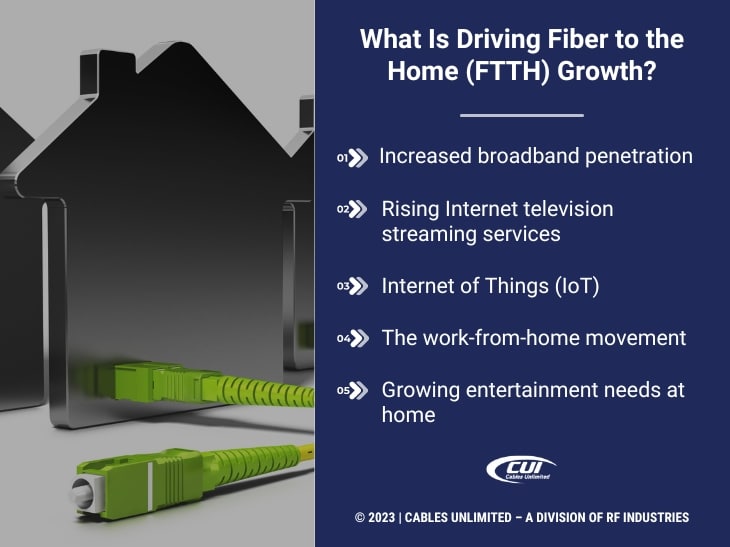
What Is Driving Fiber to the Home (FTTH) Growth?
As stated above, the significant growth in FTTH has been from increased broadband penetration, rising Internet television streaming services, and the overall growing telecommunication industry. But there is also the nascent Internet of Things (IoT) and the working-from-home movement.
Indeed, the Internet of Things (IoT), where everything is connected everywhere and always, is a significant factor driving the need for increased bandwidth and speed. That, in turn, can only really be addressed through Fiber to the Home (FTTH). But there are also a few other factors at play.
Working from home was growing before the pandemic made it mandatory. Many are staying with the approach now that everyone has tumbled to the benefits. And, of course, that requires high-speed internet delivered by fiber optic cables.
The expansion of work from home and growing entertainment needs at home means that high-speed internet is not only expected, but it’s also demanded and avoided if it’s not there. For example, the Fiber Broadband Association has found that fast and reliable broadband is one of the most important features when considering apartment rental or home purchase options. They found that rental values increase by 8% and home purchase values increase by 2.8%.
The Economic Impact of Fiber to the Home: Transforming Communities Across the USA
How Does Fiber to the Home (FTTH) Work?
As expected, fiber optic cables connect everything to the home from the central office, the transmission source. That involves an optical line terminal (OLT) at the central office. That drives an optical distribution network (ODN), a passive optical network, thereby minimizing power requirements. And along the way, passive optical splitters are used to route the signals to multiple homes.
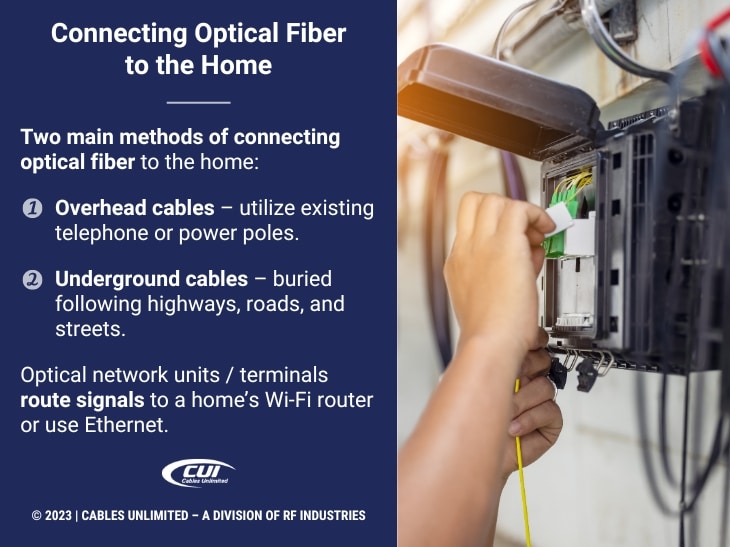
Connecting Optical Fiber to the Home
The two main methods of connecting optical fiber to the home are overhead cables and underground cables. The overhead cables approach takes advantage of the existing telephone or power poles. More likely underground cables are buried following highways, roads, and streets. You’ve undoubtedly seen several cable installation operations underway near and in your neighborhood.
At home, optical network units or terminals route the signals to the home’s Wi-Fi router or use Ethernet to get the signal to computers, televisions, and anything else involved in the Internet of Things (IoT), including refrigerators and HVAC systems.
All of that takes fiber optic cable assemblies to patch the signal from one device to another, whether at the central office, the transmission splitters, or the home. Those installations can be accomplished with either field-terminated fiber optic cable assemblies or custom pre-terminated fiber optic cable assemblies.
The significant advantages of custom pre-terminated cable assemblies are that they can be pre-tested, manufactured in quantity, and dropped into place in the field. Not only that but compared to field installation, pre-terminated fiber optic cables can save money.
They can save as much as 50% on installation costs. In addition, since the termination is precision polished and tested at the factory, these procedures are not needed in the field. Plus, there’s no need for field testing equipment or consumables, further saving time and money.
That also allows faster installation and cable performance that’s already been measured. All that further reduces waste when cutting and trying cables and connectors in the field. 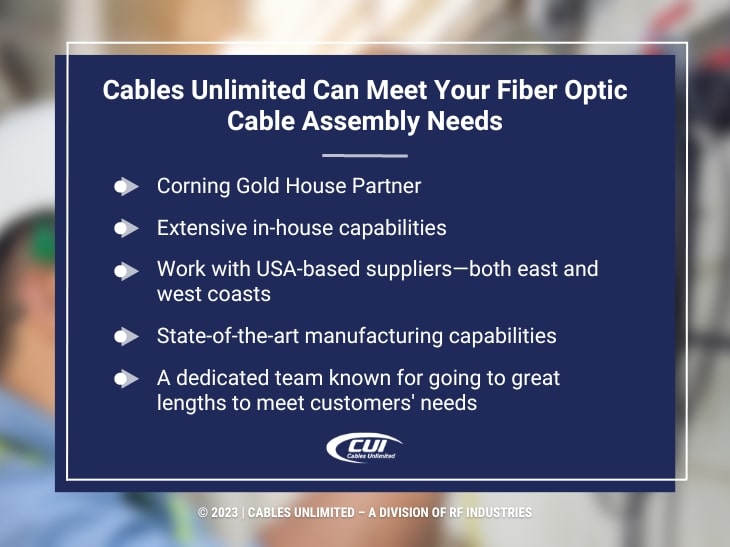
We Can Meet Your Fiber Optic Cable Assembly Needs
We are a Corning Gold House Partner and work with many other suppliers to source materials. We also have extensive in-house capabilities. Plus, we make it a special point to work with USA-based suppliers, many of them located near our manufacturing facilities on both the East and West coasts.
If your requirements are already specified and ready for a quote for your current projects, we are prepared to meet your deadlines and pricing targets. Our extensive in-house services and advanced manufacturing capabilities are in place to meet your requirements.
But Cables Unlimited offers much more than state-of-the-art manufacturing—our dedicated team is also known for going to great lengths to meet the needs of our customers, including working round-the-clock to meet tight turnaround time requirements.
Our sales representatives are standing by to assist you with product questions and quotes Monday – Friday, 8:00 am to 5:00 pm Eastern. Of course, you can also email us or complete our contact form, and we’ll get right back to you.

